Main menu
Common skin conditions

NEWS
Join DermNet PRO
Read more
Quick links
Radiation dermatitis — extra information
Radiation dermatitis
Author: Anoma Ranaweera, Medical Writer, Auckland, New Zealand, 2012.
Introduction
Clinical features
Risk factors
General management
What is radiation dermatitis?
Radiation dermatitis is a side effect of external beam ionizing radiation. It is also called radiodermatitis, x-ray dermatitis, radiation skin damage or a radiation burn.
Most commonly, radiation-induced dermatitis is caused by radiotherapy for underlying malignancies. It may also rarely result from exposure to radiation during interventional procedures such as coronary angiography, embolization procedures, and indwelling catheter placements.
Irradiation of the skin leads to a complex pattern of direct tissue injury involving damage to cells of the epidermis and endothelial cells within the walls of blood vessels, and inflammatory cell recruitment.
What are the clinical features of radiation dermatitis?
Radiation dermatitis generally manifests within a few days to weeks after the start of radiotherapy. Its onset varies depending on the radiation dose intensity and the normal tissue sensitivity of individuals. It is confined to areas of skin that have been irradiated, and the skin changes are sharply demarcated.
Radiation-induced dermatitis can be classified as acute or chronic.
Acute radiation dermatitis
Acute radiation dermatitis occurs within 90 days of exposure to radiation. The patient may have skin changes ranging from faint erythema (reddening) and desquamation (peeling skin) to skin necrosis (death of skin cells) and ulceration, depending on the severity of the reaction.
The National Cancer Institute (USA) has developed 4 criteria for the classification of acute radiation dermatitis:
- Grade 1 – Faint erythema or desquamation.
- Grade 2 – Moderate to brisk erythema or patchy, moist desquamation confined to skin folds and creases. Moderate swelling.
- Grade 3 – Confluent, moist desquamation greater than 1.5 cm diameter, which is not confined to the skin folds. Pitting oedema (severe swelling).
- Grade 4 – Skin necrosis or ulceration of full-thickness dermis (middle layer of skin).
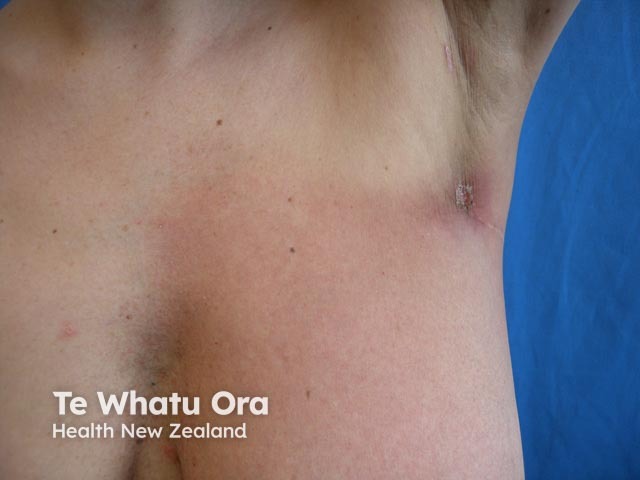
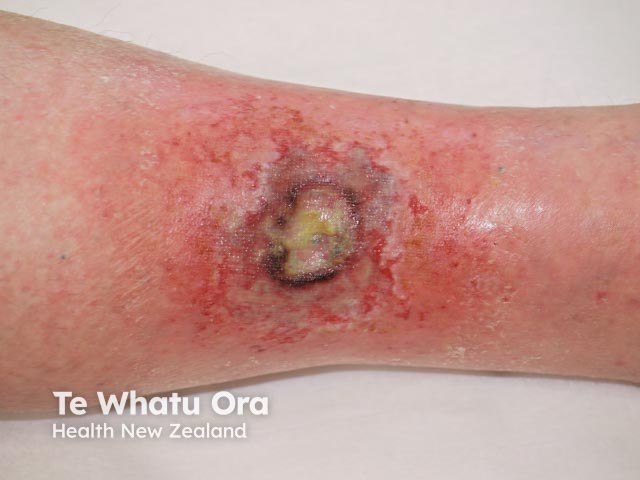
Acute radiation dermatitis
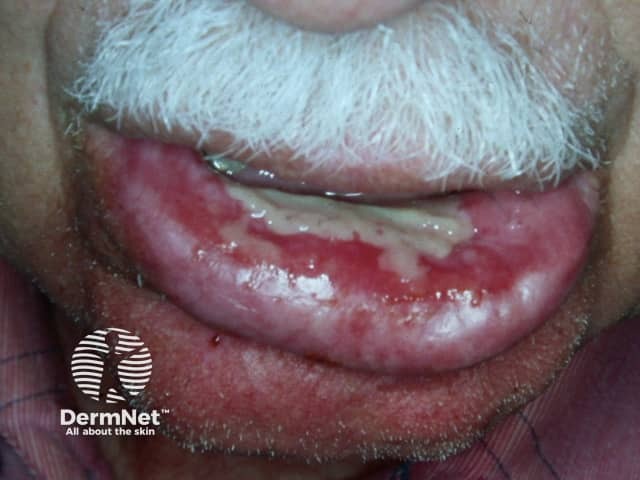
Radiation-induced stomatitis
Chronic radiation dermatitis
The onset of chronic radiation dermatitis may occur from 15 days to 10 years or more after the beginning of radiation therapy. It is an extension of the acute process and involves further inflammatory changes in the skin.
Chronic radiation-induced changes in the skin are characterised by:
- The disappearance of follicular structures (pores)
- An increase in collagen and damage to elastic fibres in the dermis
- A fragile surface skin (epidermis)
- Telangiectasia (prominent blood vessels).
Secondary skin cancers may also result from repeated exposure to radiation therapy, most commonly basal cell carcinoma.
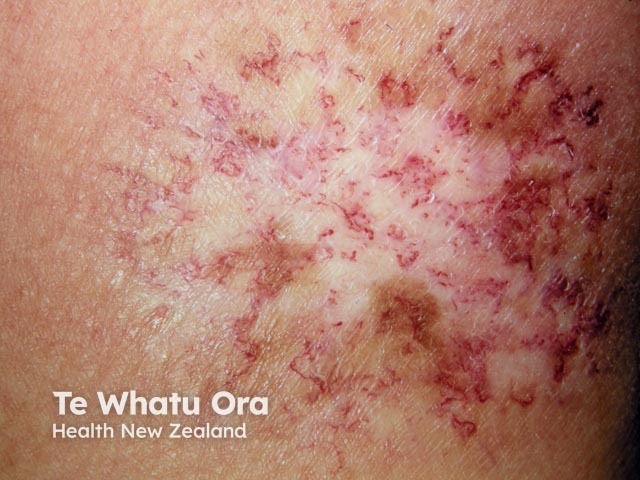
Chronic radiation dermatitis
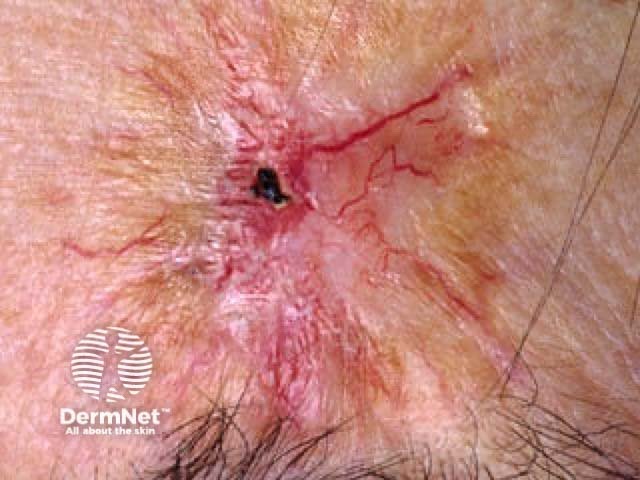
Chronic radiation dermatitis
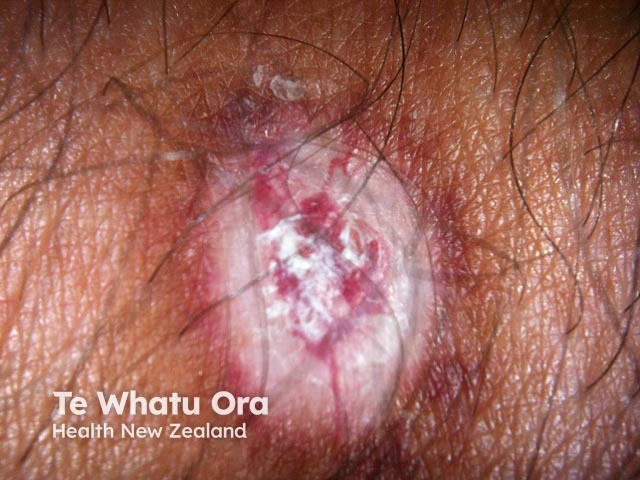
Chronic radiation dermatitis
Radiation recall
Radiation recall is rare. It occurs at sites of previous radiation therapy after a chemotherapy agent (e.g. methotrexate or etoposide) is given. The reaction may occur weeks to years after radiation.
Radiation recall ranges from sunburn-like erythema to necrosis, ulceration, and bleeding.
Risk factors for radiation dermatitis
Radiation-induced dermatitis is more likely to occur in patients with certain risk factors:
- Poor nutrition
- Pre-existing skin disease
- Application of skin creams to the exposed area immediately before treatment
- Overlapping skin folds
- Obesity
- Prolonged or multiple procedures requiring radiation exposure
- Total radiation doses of greater than 55 Gy, or large individual doses per fraction (greater than 3–4 Gy per dose)
- Concurrent cetuximab therapy, in patients receiving radiation for head and neck malignancies.
Certain diseases and syndromes increase the risk of radiation dermatitis. These include:
- Connective tissue diseases (Systemic lupus erythematosus, systemic sclerosis, or mixed connective tissue disease)
- Genetic disorders affecting epidermal DNA, such as basal cell naevus syndrome
- Chromosomal breakage syndromes, such as Fanconi anaemia and Bloom syndrome
- Ataxia telangiectasia
- Certain infectious diseases, particularly human immunodeficiency virus (HIV)
- Diabetes mellitus
- Cellular damage due to a preceding radiosensitising drug (e.g. paclitaxel or docetaxel).
General management of radiation dermatitis
Patients with acute radiation dermatitis should be carefully assessed.
- Check that the radiation dose and distribution are correct.
- Consider discontinuing the concomitant medication that may have contributed to the reaction.
- Consider alternative explanations for the skin changes, such as contact dermatitis or infection.
Patients may wash the affected skin with a gentle non-soap cleanser and dry it with a soft, clean towel before each irradiation session. Emollients, moisturisers, gels, emulsions and dressings applied after treatment may reduce discomfort.
Topical corticosteroids may be prescribed for radiation dermatitis for 2 to 4 weeks. It is uncertain whether these are of benefit.
Patients receiving radiation therapy should be advised to avoid:
- Sun exposure by covering the treated area with protective clothing or SPF 50+ broad-spectrum sunscreen
- Topical skin irritants, such as perfumes, deodorants and alcohol-based lotions
- Scratching of the skin in the affected area.
References
- J. Bernier, J. Bonner, J. B. Vermorken, RJ. Bensadoun et al. Consensus Guidelines for the Management of Radiation Dermatitis and Coexisting Acne-like Rash in Patients Receiving Radiotherapy plus EGFR Inhibitors for the Treatment of Squamous Cell Carcinoma. Ann Oncol 2008:19(1):142–9. PubMed
- Feigh D, Baney T, Bruce S, et al. Evidence-Based Interventions for Radiation Dermatitis. Clin J Oncol Nurs 2011:15(5):481–92. PubMed
- Hymes SR, Strom EA, Fife C. Radiation dermatitis: Clinical presentation, pathophysiology and treatment 2006. J Am Acad Dermatol 2006; 54:28-46. PubMed
- Richardson J, Smith JE, McIntyre M, Thomas R, Pilkington K. Aloe vera for preventing radiation-induced skin reactions: A systematic literature review. Clin Oncol 2005;17:478–84. PubMed
- Maddocks-Jennings W, Wilkinson JM, Shillington D. Novel approaches to radiotherapy-induced skin reactions: A literature review. Complement Ther Clin Pract 2005;11:224–31. PubMed
- Salvo N, Barnes E, van Draanen J, Stacey E, Mitera G, Breen D, et al. Prophylaxis and management of acute radiation-induced skin reactions: A systematic review of the literature. Current Oncology 2010; 17(4): 94–112. PubMed
- Ryan JL. Ionizing Radiation: The Good, the Bad, and the Ugly. J Invest Dermatol 2012;132:985–93. doi:10.1038/jid.2011.411. PubMed
On DermNet
Other websites
- Radiation dermatitis photos — Dermnet.com skin disease atlas
- Radiation Therapy for Cancer — National Cancer Institute
